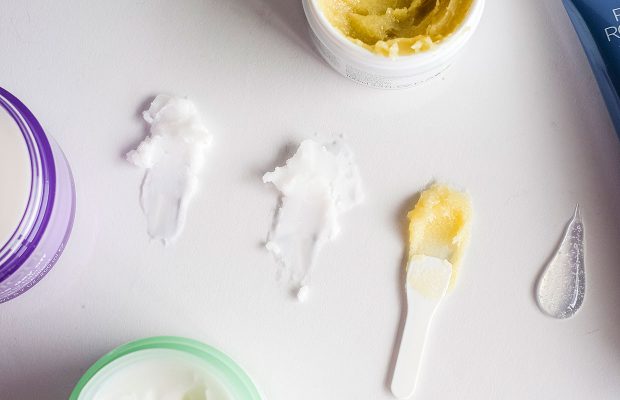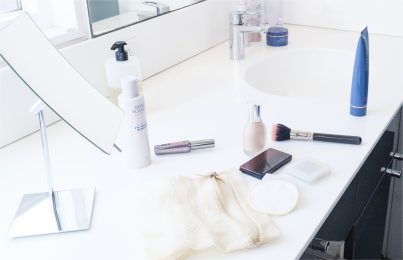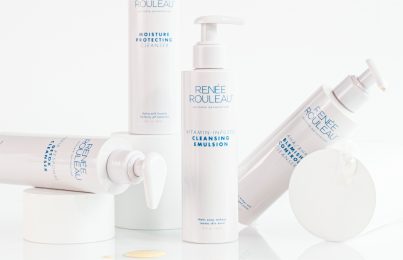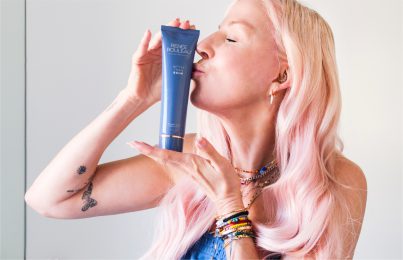By now, most people are familiar with the double-cleansing method first made popular by Korean beauty bloggers. It’s pretty much exactly what it sounds like: in the evening, you cleanse your skin twice using a separate cleansing product for each step. The first cleanser is meant to remove makeup, sunscreen, and any other products that are tough to get off. Then, cleanse number two is meant to actually clean your face, removing pollutants and other impurities you can’t necessarily see. Ideally, you’re left with a perfectly clean slate that’s ready to drink in all your reparative nighttime skincare products.
In this post, I’ll go over the benefits of a double cleanse and the two big mistakes most people make (that can actually make your skin worse).
What Are the Benefits of a Double Cleanse (and Should I Do One Nightly)?
For starters, not everyone needs to double cleanse every night. Double cleansing should be reserved for when you’re wearing something stubborn on your skin, like waterproof sunscreen or heavy makeup (think long-wear foundation and cream blush). For some, that means double cleansing only on special occasions. Others might make it part of their nightly routine! In any case, I do think double cleansing can be beneficial when done correctly. Let me explain why.
Imagine you’re wearing layers of skincare, sunscreen, full-coverage foundation, and cream blush. Most of these products have oils in them, so it’s a lot to ask of one cleanser to break down all those layers AND clean your skin. While one cleanse might take off a decent amount of makeup, your skin won’t be truly clean at the end. You also run the risk of just smearing dirt and makeup particles around instead of removing them. (This is also the reason I’ve never been a fan of cleansing wipes—they do the same thing.)
The reason it’s so important to have an effective cleansing routine is that it allows your nighttime products to work more effectively. If there’s still a film of makeup, oil, or grime on your face, it’s harder for serums to penetrate into your skin where they can work their magic, as they’re designed to do. Ingredients like peptides, retinol, and antioxidants are essential for encouraging and supporting your skin’s nighttime repair process.
How Does Double Cleansing Work?
At its core, double cleansing consists of two basic steps: 1) remove your makeup 2) clean your skin. There are a few different ways to go about this.
For the first step, aka makeup removal, most people use either micellar water (made popular by French skincare) or an oil-based cleanser, like a balm. Both are effective, but for really heavy-duty makeup, I find a balm is usually best. This is because “like dissolves like,” meaning the oil in the cleanser will break down the oils in your makeup and sunscreen.
- Apply your balm cleanser to dry skin and massage for 60 seconds to properly break down sunscreen and makeup.
- Rinse your face with lukewarm water.
- Using a soft, damp cloth, gently but thoroughly wipe your face to lift away all that loosened makeup.
For the second step, choose a cream or gel cleanser for your skin type to complete the process. This will remove lingering sebum, pollutants, and debris that can’t be seen with the naked eye.
- Apply your cleanser to damp skin, massage thoroughly for at least 30 seconds, then rinse with water.
- Move on to your next step, like toner or serum.
Pro tip: watch out for these four ingredients your cleanser should never contain.
The Two Double Cleansing Mistakes Almost Everyone Makes
While I do think double cleansing can be beneficial, there are two really big mistakes most people make that hold them back from achieving truly clean skin.
1. Using a Traditional Cleansing Balm That’s Really Heavy or Waxy
Most solid cleansing balms are made with really heavy oils or sticky waxes. These are great at removing makeup, but the catch is that they’re incredibly hard to get off the skin. Since the whole goal is to remove makeup from your skin, this kind of defeats the purpose.
Think about it this way: if your hand is coated in oil or wax and you drip water onto it, that water will bead and roll off your hand. It won’t actually rinse that oil off your hand. This is the same thing happening on your face, and it means there’s probably an oily film being left behind on your skin. This isn’t good news for anyone prone to clogged pores or breakouts. It also creates a barrier that makes it difficult for the rest of your products to penetrate properly.
For example, let’s say you want to apply a serum after using a cleansing oil or balm. Serums are made up of small molecules so they can get deep into the skin. Oils tend to have large molecules, so if you apply a serum on top of an oily film it’s going to have a hard time getting through.
This is why that second cleanse is SO important when you use a traditional cleansing balm. The surfactants in a regular cleanser will help break down the oil deposited by the balm cleanser. Even so, it’s a lot of work and it can be difficult to guarantee you’ll get every last bit of oil off.
The Alternative
I totally get why some people like using a cleansing balm to remove makeup, and you don’t have to stop using them altogether. My suggestion? Opt for a modern, transformative cleanser instead. I created Better Than Balm, an oil-based cleanser that transforms when you add water. This allows it to emulsify and rinse off easily. It’s still important to finish by using a damp cloth to wipe everything away, but this way you only need one product instead of two. It also guarantees that you won’t be left with a nasty, oily film. Learn more about how this cleanser is formulated differently.
2. Not Using a Washcloth to Fully Remove Makeup
I’ve mentioned a few times now that when using a balm cleanser to remove makeup, you should use a gentle cloth as the final step. This step is so much more important than people realize, and it’s often overlooked. While your balm cleanser is breaking down and loosening the makeup and sunscreen particles on your skin, you need the mechanical action of a cloth to physically lift those particles off. Otherwise, you’re just smearing them around.
I hope this clears up any questions you had about the popular double-cleansing trend! Just remember, it’s not necessary for everyone to double cleanse. Reserve it for occasions when you’re wearing stubborn sunscreen or makeup, and be sure to follow my steps so that you’re doing it correctly.
Up next, this is the best way to remove eye makeup without causing wrinkles.
Celebrity Esthetician & Skincare Expert
As an esthetician trained in cosmetic chemistry, Renée Rouleau has spent 30 years researching skin, educating her audience, and building an award-winning line of products. Her hands-on experience as an esthetician and trusted skin care expert has created a real-world solution — products that are formulated for nine different types of skin so your face will get exactly what it needs to look and feel its best. Trusted by celebrities, editors, bloggers, and skincare obsessives around the globe, her vast real-world knowledge and constant research are why Marie Claire calls her “the most passionate skin practitioner we know.”




Comments:
Hello,
Interesting article. Since you don’t believe in cleansing balms, what do you recommend to take off makeup before cleansing? I have acne prone skin and am using a bha cleanser at night and don’t feel right using that to remove makeup.
Posted By: Lauren |
Hi Lauren! I have two great cleanser options for that! The vitamin-infused cleansing emulsion, and the soothing aloe cleansing milk! These cleansers work to dissolve oil, debris, and makeup while making the skin look calm and refreshed.
Posted By: Renée Rouleau |
Hi Renee,
I have melasma and have dehydrated skin. I’m in my early 40’s so probably drier too. I use a thick moisturizer but my skin feels tight and uncomfortable despite this. I use micellar water as a first step to remove the many layers of sunscreen I have on and then cleanse with gentle cleanser with a bamboo cloth. I think the cloth may be irritating my skin, despite its softness. If one doesn’t/can’t use a cloth, what do you do? If I used an oil cleanser first followed by gentle cleanser (no cloth) doesn’t the cleanser help remove the oil when rinsing it all off?
I tried just cleansing with lotion/cloth, and I still had product residue on my face.
Posted By: lara |
Hello there! I would suggest skipping your micellar water for all purposes except eye makeup removal. Creamy cleansers are designed to be applied to dry skin so using micellar water as your first step will make your cleansing lotion less effective. If you find that you need a second cleanse after the creamy cleanser you can follow with a second cleanse using a gel cleanser. The Moisture Protecting Cleanser is a good option for your concerns. The best option for removing products like cleansers and masks is baby wash cloths. They are super soft and dry quickly!
Posted By: Renée Rouleau |
Hello! I’ve been really struggling to figure out how to go about my cleansing routine as I work very early in the morning coaching a couple of classes, then go to the gym during the day and then go back to work in the afternoon.. I know I need to wear sunscreen all day and is put it on before and after I go the gym. But does hat mean I should be double cleaning twice a day to get the sweat and sunscreen off??? I’d appreciate and advice!
Posted By: Ele |
Hi there! You really don’t need to double cleanse unless you have long-wear makeup on or aren’t using a cream cleanser. Simplify your routine at night by using a cream cleanser and following with a toner. Of course, be sure to choose items that suit your skin type.
Posted By: Renée Rouleau |
Renée, what make up removing cleanser can skin type 3 use? I don’t feel right cleansing a full face of make up with BHA Cleanser. I’ve used the gentle all skin type gel based – brands Fresh soy, Kiehl’s etc.
Posted By: Ashley Cordell |
Try Soothing Aloe Cleansing Milk!
Posted By: Renée Rouleau |